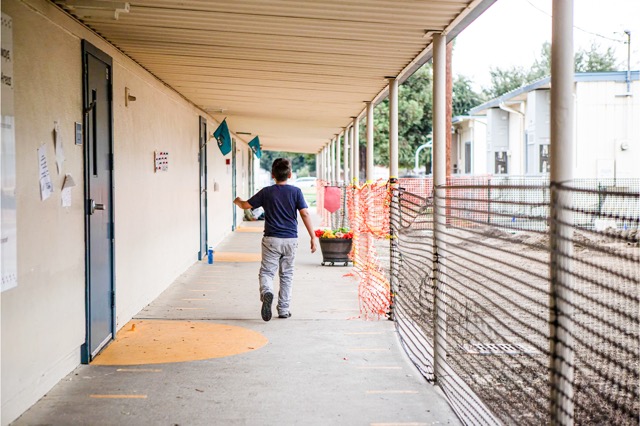California School Bond
BY CAROLYN JONES, CalMatters
The Legislature announced today a $10 billion bond to pay for repairs and upgrades at thousands of K-12 school and community college buildings across California, some of which have languished for years with dry rot, mold, leaks and other hazards due to lack of funds. K-12 schools would get $8.5 billion and $1.5 billion would go to community colleges.
“This money is badly needed,” said Rebeca Andrade, superintendent of Salinas City Elementary District in Monterey County. “We don’t have the money to make the basic, structural repairs that are needed at every one of our schools. Students need safe spaces to learn if they’re going to reach their full potential.”
The agreement comes after months of wrangling by lawmakers and Gov. Gavin Newsom, who had to choose between two competing school facilities bills – one that included four-year colleges and one that didn’t. Assembly Bill 247, sponsored by Al Muratsuchi, a Democrat from Torrance, had the edge because it asked for less money and because four-colleges have their own means of raising funds. The bond needs a ⅔ approval majority in both houses and Newsom’s signature.
Originally, the bill asked for $14 billion, which would have made it one of the largest school bonds in state history. The amount dropped to $10 billion because lawmakers wanted to cap the overall amount of bond money on the fall ballot, Muratsuchi said today.
“The bottom line is, any school bond that we place on the ballot is not going to cover the enormous needs of our K-12 schools and community colleges,” Muratsuchi said. “But this money will help address the most urgent needs. … I am hopeful and optimistic that California voters will recognize that this is a good deal.”
Originally, the bill asked for $14 billion, which would have made it one of the largest school bonds in state history.
There were several potential bonds competing for room on the fall ballot, but Newsom hinted he was leaning toward the school bond in his revised budget proposal. That called for draining the remaining $375 million in an existing school facilities fund and eliminating a $550 million grant program that would have paid for new kindergarten and preschool classrooms. He noted in his proposal that a school facilities bond could fill both those funds. The proposal ended up as part of the final budget.
“We need help. It’s become an issue of equity — our students deserve safe conditions for learning like everyone else.”
REBECA ANDRADE, SUPERINTENDENT OF SALINAS CITY ELEMENTARY DISTRICT
No dedicated funding stream
Money to fix California’s schools is sorely needed. In 2020, voters rejected a $15 billion school facilities bond, leaving the state’s school repair fund – last replenished in 2016 – nearly empty.
Unlike most states, California doesn’t have a dedicated stream of funding to repair school buildings. Money comes from state or local bonds — a system that benefits more affluent districts, according to a recent report from the Public Policy Institute of California. State money usually requires matching funds from the district, which is easier to raise in wealthier areas where voters are more apt to approve bonds and where bonds raise more money because property values are higher. Rural districts and those with higher numbers of English learners, Latino and low-income students typically have the hardest time securing money to fix school buildings.
Plenty of research points to the link between student achievement and the condition of school buildings. Students whose schools are modernized, clean and safe tend to have higher test scores, lower suspension rates and higher rates of attendance.
The unequal way California distributes school repair funds prompted Public Advocates, a nonprofit law firm, to threaten to sue the state, claiming the system is unconstitutional. Public Advocates has been urging the state to adopt a sliding scale that would allow smaller and low-income districts to collect more state funds to make needed repairs.
As part of the agreement, the bond includes a sliding scale and extra help for small districts and those that can’t raise local bond money. But it’s not nearly enough, said Public Advocates managing attorney John Affeldt.
“It’s an insult to call this a sliding scale,” Affeldt said. The bond would provide state matching grants ranging from 60% to 65%, depending on a district’s number of high-needs students and the amount of money it can raise through local bonds. Public Advocates has been pushing for a sliding scale ranging from 5% to 90%, which Affeldt said benefits districts that need the money most.
The scale suggested by the state benefits districts like Los Angeles Unified and San Francisco Unified, which have high property values and plenty of local bond money, Affeldt said. Those districts stand to gain millions from the bond, while lower-income districts such as Lynwood Unified in Los Angeles County and Del Norte Unified in far northwestern California, will miss out.
Public Advocates has not decided whether to proceed with its lawsuit. It may wait until after voters have weighed in, Affeldt said.
“The Legislature is shooting itself in the foot. What they’ve proposed will only undermine support from voters,” Affeldt said. “But technically they still have time to fix this.”
The bond needs a simple majority to pass in November, but it’s not clear how receptive voters will be. In light of economic worries, 64% of voters said this is a “bad time” for state bonds, according to a survey released in June by the Public Policy Institute of California. At the same time, respondents said that K-12 education was their second-highest priority for state spending, just behind health and human services.
‘We need help’
Salinas City Elementary, where half the students are English learners and more than 75% are low-income, has struggled for decades with building repairs and upgrades at its 15 campuses. Walls are cracked, roofs leak, window frames are rotten, some schools lack air conditioning and wheelchair ramps are pocked with holes. The district lacks a large stage for performances, or a decent STEM lab. A recent survey of all needed repairs put the cost at $500 million.
In 2022, local voters overwhelmingly passed a pair of school facilities bonds, despite the fact that the bonds will raise property taxes in the predominantly low-income community. But the bonds will only bring in $149 million, not nearly enough to meet the need. That’s why the state bond money is crucial, Andrade said.
“This community is amazing. They value education and they trust us,” Andrade said. “But we need help. It’s become an issue of equity — our students deserve safe conditions for learning like everyone else.”
For More Education News Visit www.zapinin.com/education.


